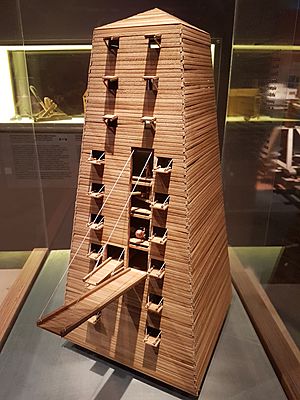Helepolis facts for kids
The Helepolis was a giant war machine used in ancient times. Imagine a huge moving tower, taller than many buildings, designed to help armies attack strong city walls! Its name, "Helepolis," comes from ancient Greek and means "Taker of Cities." This powerful machine was one of the biggest and strongest siege towers ever built.
Contents
What Was the Helepolis?
The Helepolis was a special type of siege engine. A siege engine is a machine built to help an army attack a fortified place, like a city with strong walls. The Helepolis was designed to bring soldiers right up to the top of enemy walls. It was like a mobile fortress on wheels.
A Giant War Machine
This incredible machine was truly massive. It was described by ancient writers like Vitruvius and Plutarch. They wrote about its huge size and power. The Helepolis was much larger than earlier siege towers. It was built to be strong enough to withstand attacks.
Its Name and Purpose
The name "Helepolis" comes from two Greek words: "helein" (to take) and "polis" (city). So, it literally means "Taker of Cities." Its main purpose was to help an army capture a city. It did this by allowing soldiers to climb over high walls. It also protected them from arrows and other attacks.
Famous Battles and Uses
The Helepolis is most famous for its use in a very important battle. This was the siege of Rhodes in 305 BC.
The Siege of Rhodes
The city of Rhodes was a powerful island city in ancient Greece. It was attacked by a general named Demetrius I of Macedon. He was known as "Demetrius Poliorcetes," which means "Besieger of Cities." Demetrius brought the Helepolis to try and break through Rhodes' strong defenses.
The Helepolis used at Rhodes was truly enormous. It was said to be about 40 meters (130 feet) tall. That's as tall as a 12-story building! It was also very wide, about 20 meters (65 feet). It had many levels, each with openings for archers and other soldiers. These soldiers could shoot arrows and throw spears at the defenders on the city walls.
Moving such a huge machine was a massive task. It needed hundreds, maybe even thousands, of soldiers to push it. It also had large wheels to help it roll across the ground. However, despite its size and power, the Helepolis did not succeed in capturing Rhodes. The defenders of Rhodes were very clever. They dug ditches in front of their walls. This made it impossible for the Helepolis to get close enough to attack.
Earlier Designs
The Helepolis used at Rhodes was not the first of its kind. There was an earlier, smaller version. This earlier siege tower was used in the Battle of Salamis in 306 BC. This battle took place on the island of Cyprus. The success of that smaller tower likely inspired the creation of the even larger Helepolis for the siege of Rhodes.
How Siege Towers Worked
Siege towers like the Helepolis were important tools in ancient warfare. They were built to overcome the challenge of high city walls.
Reaching the Walls
The main idea of a siege tower was to create a movable bridge. This bridge would allow attackers to cross over the enemy's walls. The tower would be rolled right up to the wall. Then, a drawbridge-like ramp would be lowered from the top level. Soldiers could then rush across this ramp and onto the city's defenses.
Protection for Soldiers
Siege towers also offered protection. Their thick wooden walls shielded soldiers inside from arrows, rocks, and other projectiles. This meant that soldiers could safely approach the walls. They could then attack the defenders from a protected position. Some towers even had battering rams at their base. These rams were used to smash holes in the lower parts of the walls.
Different Types of Towers
Over time, many different types of siege towers were built. They varied in size and design. Some were simple wooden structures. Others, like the Helepolis, were complex engineering marvels. They often had multiple levels, each with different types of weapons. They were a testament to the ingenuity of ancient engineers.
Images for kids
See also
 In Spanish: Helépolis para niños
In Spanish: Helépolis para niños



